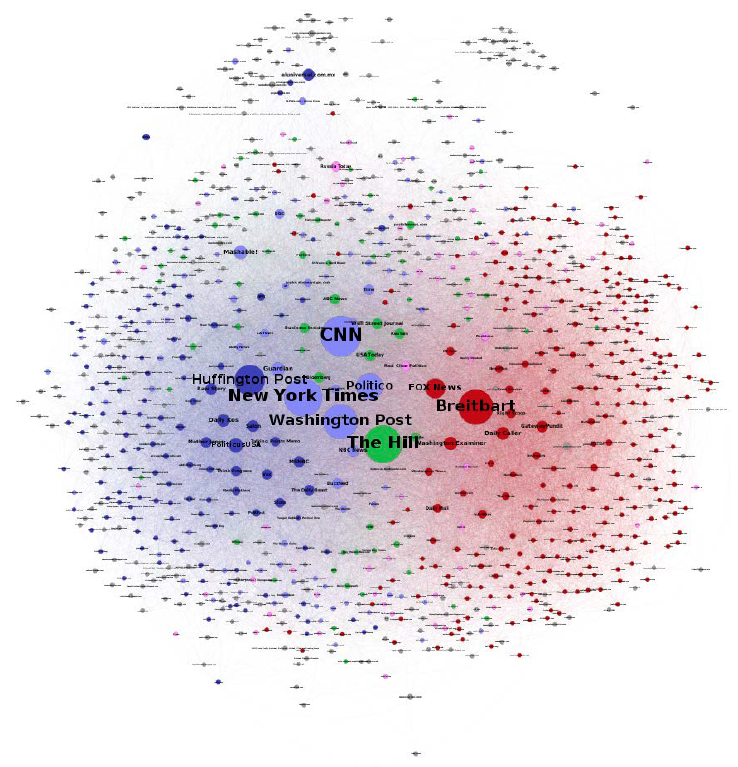Partisan Right-Wing Websites Shaped Mainstream Press Coverage Before 2016 Election, Berkman Klein Study Finds
untitled 2017-08-16
Summary:
Teaser
The Berkman Klein Center for Internet & Society at Harvard University today released a comprehensive analysis of online media and social media coverage of the 2016 presidential campaign. The report, "Partisanship, Propaganda, and Disinformation: Online Media and the 2016 U.S. Presidential Election," documents how highly partisan right-wing sources helped shape mainstream press coverage and seize the public’s attention in the 18-month period leading up to the election.

The Berkman Klein Center for Internet & Society at Harvard University today released a comprehensive analysis of online media and social media coverage of the 2016 presidential campaign. The report, "Partisanship, Propaganda, and Disinformation: Online Media and the 2016 U.S. Presidential Election," documents how highly partisan right-wing sources helped shape mainstream press coverage and seize the public’s attention in the 18-month period leading up to the election.
"In this study, we document polarization in the media ecosystem that is distinctly asymmetric. Whereas the left half of our spectrum is filled with many media sources from center to left, the right half of the spectrum has a substantial gap between center and right. The core of attention from the center-right to the left is large mainstream media organizations of the center-left. The right-wing media sphere skews to the far right and is dominated by highly partisan news organizations,” co-author and principal investigator Yochai Benkler stated. In addition to Benkler, the report was authored by Robert Faris, Hal Roberts, Bruce Etling, Nikki Bourassa, and Ethan Zuckerman.
The fact that media coverage has become more polarized in general is not new, but the extent to which right-wing sites have become partisan is striking, the report says.
The study found that on the conservative side, more attention was paid to pro-Trump, highly partisan media outlets. On the liberal side, by contrast, the center of gravity was made up largely of long-standing media organizations. Robert Faris, the Berkman Klein Center’s research director, noted, "Consistent with concerns over echo chambers and filter bubbles, social media users on the left and the right rarely share material from outside their respective spheres, except where they find coverage that is favorable to their choice of candidate. A key difference between the right and left is that Trump supporters found substantial coverage favorable to their side in left and center-left media, particularly coverage critical of Clinton. In contrast, the messaging from right-wing media was consistently pro-Trump." Conservative opposition to Trump was strongest in the center-right, the portion of the political spectrum that wielded the least influence in media coverage of the election.
In this recently-emerged universe, Breitbart stands at the center of a right-wing media ecosystem and is surrounded by sites like Fox News, the Daily Caller, the Gateway Pundit, the Washington Examiner, Infowars, Conservative Treehouse, and Truthfeed, according to the report’s analysis.

Figure 8: Network map based on Twitter media sharing from May 1, 2015, to November 7, 2016 with nodes sized by number of Twitter shares (explore this map in higher resolution)
The report finds that political clickbait sites—hyperpartisan sites that frequently engage in dubious reporting—exist on both sides of the political spectrum, but these sites played a larger role on the right than the left. On the more insular and partisan right, the “fake news,” or political clickbait sites were a more integral part of the media sphere. On the left, readers gravitated towards center-left large media organizations which moderated the impact of political clickbait on the left. This overall trend and the quantitative differences in coverage were far more consequential than the circulation of outright false stories, the analysis found. "Although fake news--fabricated and verifiably false reporting--was a phenomenon during the election, it had a minor effect on the media ecosystem of the presidential election according to our findings. A much larger concern was the misleading reporting that was propagated through partisan networks," co-author and Med